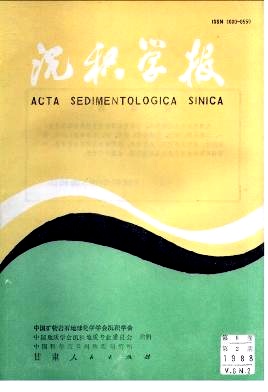Meng Zifang. A PALEOMAGNETSC STUDY OF XINMINBU FORMATION OF HANXIA SECTION, YUMEN, GANSU[J]. Acta Sedimentologica Sinica, 1988, 6(2): 106-117.
| Citation:
|
Meng Zifang. A PALEOMAGNETSC STUDY OF XINMINBU FORMATION OF HANXIA SECTION, YUMEN, GANSU[J]. Acta Sedimentologica Sinica, 1988, 6(2): 106-117.
|
A PALEOMAGNETSC STUDY OF XINMINBU FORMATION OF HANXIA SECTION, YUMEN, GANSU
- Received Date: 1986-02-24
- Publish Date:
1988-06-10
-
Abstract
Hanxia Section is situated in the piedmont of the northern slope of the Qilianshan (Nanshan) Mountains, with a distance of some 28km, due west fo Yumen, Gansu Province. The section stretches approximately in a direction of north-sourth. The Mesozoic strata of the section appears as overturned monoclinal strata dipping steeply towards SSW. Dips of the strata are from 60 to 85 degrees. All the strata of the Mesozoic age exposed in the section were previously termed as Xinminbu Formation as a whole. Purely based on the independent data reflected by the plaeomagnetic measurements obtained from 38 samples, 181 specimens, collected from Hanxia Section, a new point about the stratigraphic division of the so-called Xinminbu Formation which was originaly defined as Lower Cretaceous Series is proposed in the present paper. Stratigraphers have paid special attentions to Xinminbu Formation for a long time because of its typicalness and representativeness in continental Mesozoic strata in Northwestern China. However, biostratigraphers have not reached unanimous views on the problem that which geological period of Xinminbu Formation should belong to, up to now. They, therefore, hold different opinions on stratigraphic division of Xinminbu Formation exposed in Hanxia Section. Some of them regard that Xinminbu Formation entirely belongs to the Lower Cretaceous Series, whereas others believe that the lower of it should belong to the Upper Jurassic and the upper of it still represents Lower Cretaceous. Moreover, few hold that Sinminbu Formation belongs to the Upper Jurassic as a whole. Still others deem that we should give it a general name of Jura-Cretaceous. Three characteristic magnetic curves and a magnetic polarity zonation of Hanxia Section have been drawn out on the basis of the data of paleomagnetic measurements of oriented samples gathered from the section (Fig. 1). By means of comparing the magnetic polarity zonation with the world's Mesozoic paleomagnetic polarity stratigraphy and the paleomagnetic polarity scale of oceanic sediments, both 7 normal and 7 reversed polarity subzones have been identified from the results of so-called Xinminbu Formation of this section. Consequently, the writer believes that the Xinminbu Formation of Hanxia Section includes two stratigraphic units belong to different geological times. Taking Serra Geral reversed polarity subzone as a boundary, the Xinminbu Formation of the section can be divided into two parts which in fact belong to two different geological periods respectively. The lower, to a thickness of 459.8m, should be regarded as sediment of Late Jurassic age. The upper is still of Lower Cretaceous Series, being 635.5m thick. The two are of successive sediments. No sedimentary hiatus exists between them. Concretely speaking, the strata beneath the third reversed subzone, corresponding to Serra Geral reversed subzone, should be taken as the Upper Jurassic Series. These Jurassic strata include both all of the normal polarity members belong to Graham normal polarity zone, a thickness of about 344 m, and those belong to the mixed polarity zone, which embrace both 2 normal and 2 reversed subzones, about 116m thick. Therefore, Layer of No.8, the thick-bedded conglomerate with a dark grey colour, is the uppermost layer of Jurassic Series; whereas Layer of No.9, the grey-black paper shale and the grey-green conglomerate, is the lowermost layer of Cretaceous. It is here that the boundary between Jurassic and Cretaceous exposed within Hanxia Section. As for the ages of the basaltic dikes existing in the section, the writer thinks paleomagnetically that the eruption of them should precede the Miocene and postdate the Early Cretaceous. In addition, the eruption consists of two magmatic activities of different times. Besides these, the writer gives out the comparison of the magnetostratigraphic division with the preexisting biostratigraphic division (Fig.2.) The writer does not think it is a good idea for geologists to continuce using such a petrological stratigraphic term, Xinminbu Formatio
-
References
|
[1]
|
徐仁,周和仪,1956根据抱粉组合推论甘肃酒泉下惠回堡系底部的地质时代,古生物学报,第4卷,第4期。 |
|
[2]
|
徐仁,周和仪,1956根据抱粉组合推论甘肃酒泉下惠回堡顶部的地质时代.古生物学报,第4卷,第4期。 |
|
[3]
|
刘东生,1957,古脊椎动物学报,第1卷,第2期,103-122页。 |
|
[4]
|
全国地层委员会:1962,中国的侏罗系和白噩系,科学出版社。 |
|
[5]
|
侯佑堂,1958,中国科学院古生物研究所集刊第一号,33-60页。 |
|
[6]
|
王水,1965,古生物学报,第13卷,第3期,463-509页。 |
|
[7]
|
徐仁,江德听,杨惠秋,1974,植物学报,第16卷,第4期,865-373页。 |
|
[8]
|
沈炎彬,1981,古生物学报,第20卷,第2期,266-272页。 |
|
[9]
|
洪友崇,1982,酒泉盆地昆虫化石,地质出版社。 |
|
[10]
|
马其鸿,1 ss 2,酒泉盆地西部赤金堡组与新民堡群的划分,对比,地层学杂志,第6卷,第2期。 |
|
[11]
|
马风珍,1984,甘肃酒泉盆地鱼化石,古脊椎动物学报,第22卷,第4期。 |
|
[12]
|
侯连海,刘智成,1984,甘肃早白要世鸟化石兼论早期鸟类的进化,中国科学B辑,1984年第3期。 |
|
[13]
|
马其鸿等,1984,地层学杂志,第8卷,第4期,255-270页。 |
|
[14]
|
Collinson D.W. et al.(editors),1967, Methods in Palaeomagnetism. Elsevier Publishing Company, Amsterdam. |
|
[15]
|
Kennett J .P. (editor),1980, Magnetic stratigraphy of sediments, Dow den,Hutchinson&Ross, Inc.,Pennsylvania |
|
[16]
|
L owrie W. et al.,1984, Earth and Planetary Science Letters, Vol.71 p.315-328 |
|
[17]
|
MacFadden B.J.et al.,1983, Q uaternary Research, V of.19 p.172-187 |
|
[18]
|
Murthy G.S.,1983, Can, J.Earth Sci.,Vol.20, p.206-216 |
|
[19]
|
Turner P.1980, Continental red beds, Elsevier Scientific Publishing Company,Amsterdam. |
-
-
Proportional views

-






 DownLoad:
DownLoad: